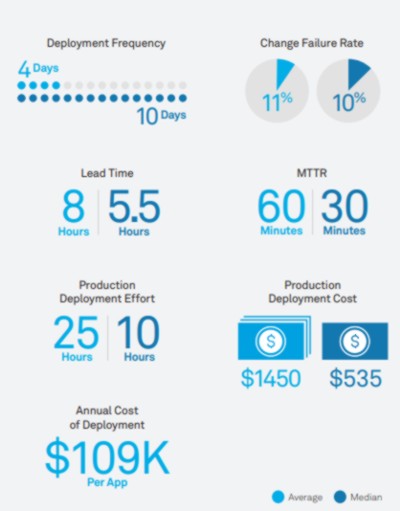| The Cost And Risk Of Code Deployments |
| Written by Alex Armstrong |
| Monday, 27 April 2020 |
|
Data from Harness, a company which offers Continuous Delivery-as-a-Service details the effort and cost involved in building and deploying new applications, including which tools developers prefer, the cost of each deployment and how frequently deployments fail. In its Continuous Delivery Insights 2020 Harness reveals that while many organizations are modernizing their DevOps practices in search of agility and speed, the vast majority are still held back by immature development practices and runaway costs. The data the report is based on was collected from over 100 corporations across multiple industries as part of Harness's sales process, Specifically it derives from Continuous Delivery Capability Assessments which help Harness create business cases and map deployment maturity. This infographic summarizes the major findings with regard to medium performing organizations, It reveals Continuous Delivery performance metrics that were observed as the Average and the Median. Conclusions to be drawn from this are:
On average, 11% of deployments fail. In response to such failures 85% of companies have a rollback strategy versus 15% of companies that choose to “roll-forward.” Rollback is the process of deploying the last working version and an average of 60 minutes was observed for manual roll back, rising to 4 hours in worst case scenarios, during which time customers may be experiencing glitches or outages.
With regard to tools, 71% of respondents use Jenkins for building and pipelines. Other popular tools include Jira for change management (76%); AWS for cloud deployments (65%) and Selenium for QA and testing (63%). In conclusion Harness recommends: To increase deployment frequency teams must move to a selfservice Continuous Delivery model where developers deploy ondemand, and pipelines are streamlined so new artifacts can be pushed to production in under an hour. To achieve this deployment pipelines need to become smarter and less reliant on people or scripts. In addition, a modern pipeline needs to orchestrate and automate QA tests, governance, deployment, verification and rollback. Without a truly ‘hands off’ approach Continuous Delivery will remain a pipe dream for most corporations.
More InformationContinuous Delivery Insights 2020 Related ArticlesHappy Developers Think More About Security
To be informed about new articles on I Programmer, sign up for our weekly newsletter, subscribe to the RSS feed and follow us on Twitter, Facebook or Linkedin.
Comments
or email your comment to: comments@i-programmer.info |
| Last Updated ( Thursday, 03 September 2020 ) |





